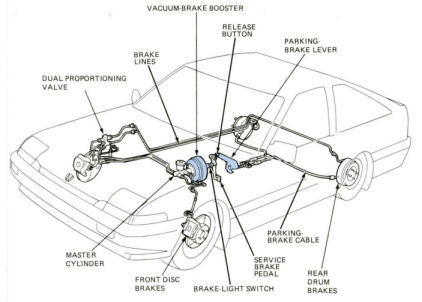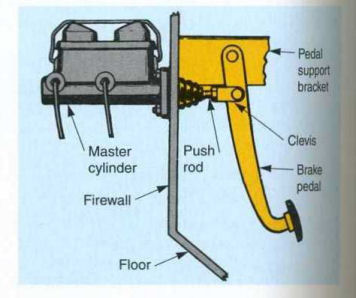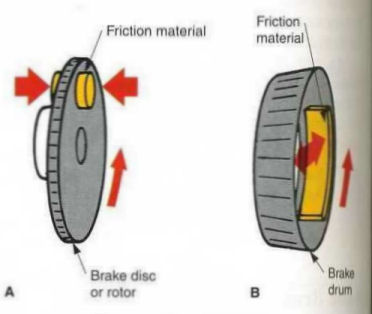|
 Braking enables the driver to slow, stop, or hold the car. It converts the mechanical
energy of a moving car into heat on the brake drum or disk. These are service brakes.
Braking enables the driver to slow, stop, or hold the car. It converts the mechanical
energy of a moving car into heat on the brake drum or disk. These are service brakes.
 Foot pedal exerts a force on the hydraulic ("brake") fluid that is transmitted to the brake
disk or drum on the wheel.
Foot pedal exerts a force on the hydraulic ("brake") fluid that is transmitted to the brake
disk or drum on the wheel.
 Disk and drum service brakes use friction to slow the wheels. A drum brake (B) has a
metal case in which are located two curved brake shoes made of fiberglass or other nonmetallic materials. When the
driver presses the foot pedal the shoes expand outward to contact the case to produce braking. A disk brake (A) has a
metal rotor (disc). The foot pedal forces flat pads against both sides of the rotor to produce braking. Usually,
disk brakes are used on the front wheels and drum brakes on the rear wheels, but either type can be used at the front or rear.
Disk and drum service brakes use friction to slow the wheels. A drum brake (B) has a
metal case in which are located two curved brake shoes made of fiberglass or other nonmetallic materials. When the
driver presses the foot pedal the shoes expand outward to contact the case to produce braking. A disk brake (A) has a
metal rotor (disc). The foot pedal forces flat pads against both sides of the rotor to produce braking. Usually,
disk brakes are used on the front wheels and drum brakes on the rear wheels, but either type can be used at the front or rear.
Parking brakes are mechanical brakes operated by a hand lever or a foot pedal. They
are used in an emergency when the hydraulic service brakes do not work. These brakes operate on the rear wheels only.
|










![[image of flower]](../../ima/flowXS_03.gif)
![[image of flower]](../../ima/flowXS_03.gif)




